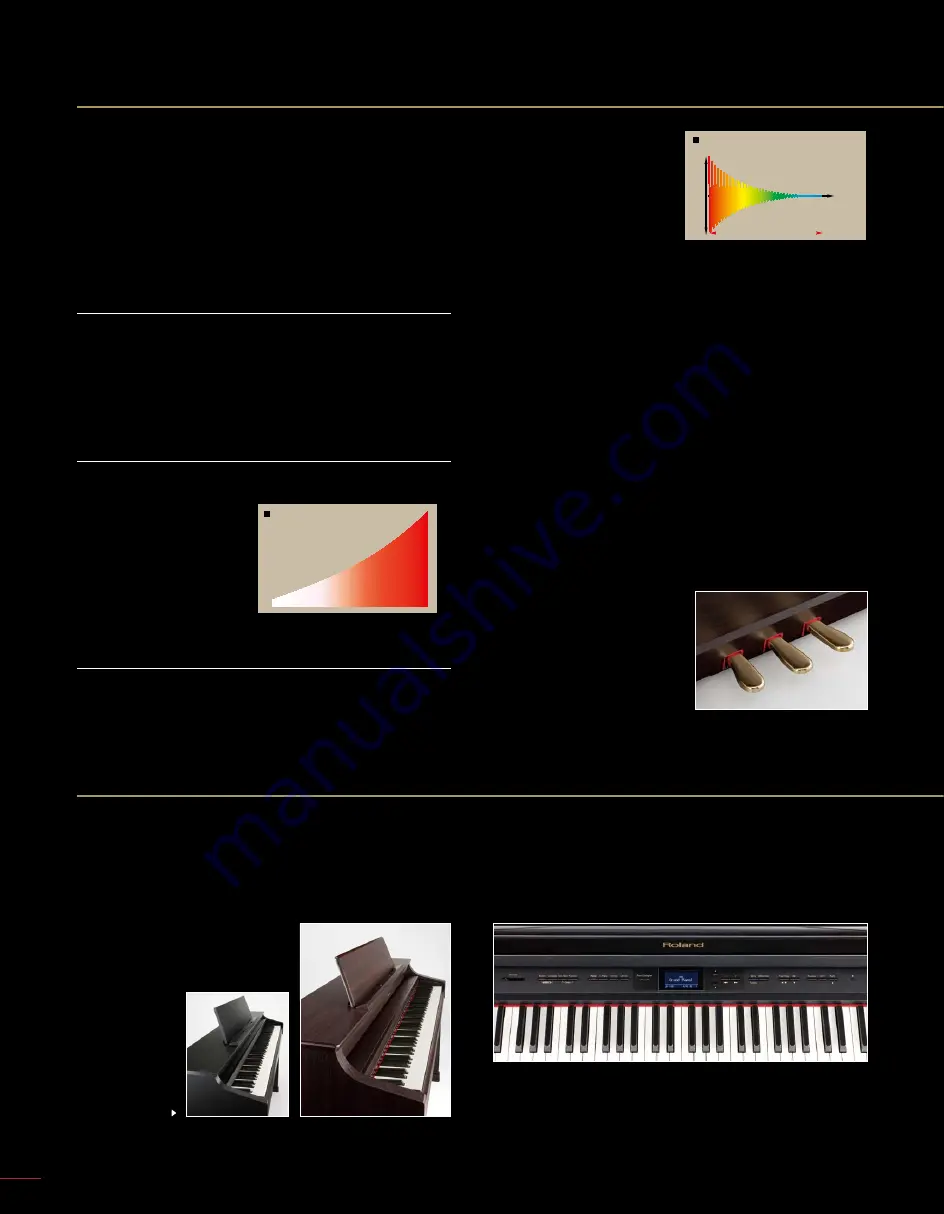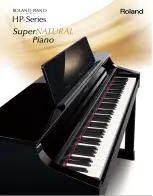
pp
p
mp
mf
ff
f
Variation in tone color produced by
the SuperNATURAL Piano sound
engine with heavier touch.
*The graph and drawings are artist's conceptions.
*The graph and drawings are artist's conceptions.
SOUND
DESIGN
The "SuperNATURAL Piano sound engine" delivers the
expressivity of an acoustic grand piano.
All models are equipped with our newly developed SuperNATURAL Piano
sound engine, which was born by bringing together V-Piano technology
and 88-key stereo multisampling technology. This new sound engine is the
product of Roland’s deep research of the characteristics of acoustic pianos,
with the goal of faithfully reproducing the rich tone and expressivity of a
concert grand piano. The maximum polyphony of 128 is more than enough
for even the most complex pieces.
Expressivity in every single key
Each of the 88 notes on a grand piano has its own character, due to the fact
that the strings are different sizes and lengths, use different materials, and
are struck by hammers of different sizes. These differences create variations
in the tone color and resonance of each note. For the new SuperNATURAL
Piano sound engine, Roland sampled all 88 notes of a variety of world-class
pianos and used its unique digital technology to faithfully reproduce the full,
rich tone and expressivity of the world’s finest pianos.
Expressivity according to the player’s touch
Pianos produce differences not only in volume, but also subtle variations
in tone color, depending on how forcefully the key is struck. Using
Roland’s latest technology, the
SuperNATURAL piano sound
engine delivers natural and
seamless changes in tone color in
response to the player’s touch. Its
expanded dynamic range supports
the most advanced and subtle
techniques, just as one would
expect in an acoustic grand piano.
Expressivity of decaying sounds
The natural decay of notes and beautiful lingering tones are important
elements of a piano’s sound. The decaying sound of an acoustic piano
Beautiful cabinet design and finishes compliment any decor
We paid meticulous attention to design details, just as we did with tone and
touch. Cabinet parts and control panels are coordinated according to wood
grain and matching colors. The front legs add both stability and style. Brass
music holders*
1
and large music rests*
2
help you manage a variety of music
scores. The three pedals have a traditional lateral design that allows smoother
pedal movements. And all models feature
the “Classic” fallboard position to conceal
the control panel and display when desired.
Available finishes include the traditional
satin black, a warm
rosewood wood
grain, and a mirror-
like polished ebony.
*1 HP307, HP305 *2 HP307,
HP305
Ease of use is always a Roland advantage.
The simple and intuitive control panel affords quick and easy access
to the HP Series’ numerous features and applications, and the
HP307 offers a large LCD panel for the ideal visual interface with the
instrument. Frequently used connection jacks are conveniently located
near the front of all models and all come with a handy headphone hook.
Inspiring expressivity made possible by Roland's
powerful technologies
All models feature "Piano Resonance", which faithfully reproduces the
sympathetic vibrations*
1
between strings, as well as other subtle nuances
such as variations in lingering tones according to how quickly keys are
released*
2
. It even replicates the resonance one hears while the damper
pedal is depressed and the dampers move off the strings*
3
. HP307 and
HP305 also offer "Grand Piano Presence
II
", which uses high and full-range
stereo speakers in a special design to replicate the unique aural “presence”
of a grand piano. High notes are heard from "above” the player and rich
basses emanate from below, near the floor. The flagship HP307 features
"Piano Designer", which lets the user customize all components of the
piano's sound, including even the position of the "virtual" grand piano lid.
*1 String Resonance *2 Key Off Resonance *3 Damper Resonance
Continuous detection pedals respond to
the player's sensitivities.
The damper and soft pedals continuously detect the slightest differences in the
amount they are depressed, thus supporting a full range of pedal expression.
For example, there are subtle changes in
tone where the damper is barely touching
the string. There are also variations in the
sustain of a sound when you depress
the pedal gradually. The pedals even
support the most subtle expression,
such as depressing the pedal again after
releasing it for an instant.
All HP series models feature
the Classic Position.
Volume
Time
Natural variations in tonal quality
Variation in tone color produced by the
SuperNATURAL Piano sound engine as the
tone decays.
not only decreases in volume, but
also gradually changes in color to
a softer tone. The SuperNATURAL
piano sound engine replicates
this natural decay, just as in an
acoustic grand.
6


























